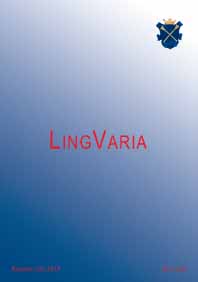BILINGWIZM W TEKŚCIE ZAPISANY. CZĘŚĆ II. WYKŁADNIKI TRANSKODOWE. GATUNKI1
Bilingualism in text. Part 2. Transcodic markers. Genres.
Author(s): Bronisława LigaraSubject(s): Language and Literature Studies
Published by: KSIĘGARNIA AKADEMICKA Sp. z o.o.
Keywords: bilingual speech; transcodic markers; matrix language/code; embedded language; Matrix Language Frame; code switching; code mixing; interference
Summary/Abstract: The second part of this paper is a description of bilingual speech recorded in three aspects, the formal, the functional, and the one relating to genre studies. As a textual phenomenon, bilingual speech is characterized by transcodic markers, the traces of encounters between two languages: the matrix language L1 and the embedded language L2. The author introduces into the text linguistic correlates of his or her bilingual competence. These can take the shape of code switching, code mixing, or interference between L1 and L2. Coherence mechanisms, adequate to the various forms of transcodic markers, weld transcodic markers with the text in the matrix language formally and with regard to the content. These mechanisms are: grammatical rules of code switching, the matrix language frame, the local grammatical, syntactic, and semantic congruence of the two linguistic systems in contact, and also the local convergence between the elements and rules of L1 and L2. Transcodic markers are created by bilingual authors to fulfil specific roles in texts, most importantly, to enhance the referential potential and to (de)nominate the text by opening up the access to the universe of reference of L2. Other functions are the deictic function, the metacommunicative function, the function of rendering utterances that have originally arisen in L2, the polyphonic function, and also the function of transmitting strong emotions which are intimate to the sender. Transcodic markers are a transgression of the monolingual norm which is typically considered the standard in the creation of written texts. However, the analysis of recorded bilingual speech has shown that there exist genres which not only accept the introduction of transcodic markers into the text, but even actually sanction them. On the one hand, it is the literature of personal document with such genres as letter, journal, memoirs (autobiography), and on the other, linguistic mediation. In the former case, transcodic markers verbalize genre-specific features, the documentary quality and the personal element, as they are a linguistic – and thus authentic – testimony of the experience that the author has had in his or her L2, and has formed in that language. Being an inalienable part of the experience that is being related, the second language warrants an assertion of truth, documented and narrated through the given text with bilingual speech. Transcodic markers introduce senses and content that is complementary to the text in the matrix language, which is why, for a bilingual author, they are a factor that enriches his or her linguistic repertoire in the text that they are creating.
Journal: LingVaria
- Issue Year: 2014
- Issue No: 18
- Page Range: 139-174
- Page Count: 36
- Language: Polish

